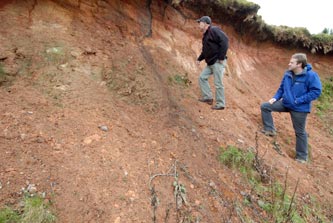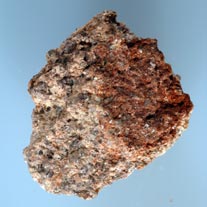What's new...
December 2009
'What's new' items from:
Macaulayite link to Mars
8 December 2009

Jeff Wilson investigating the exposure of deeply weathered granite at Bennachie in 1981
 The Institute's Colin Campbell and Steve Hillier visit the same site around 25 years later
The Institute's Colin Campbell and Steve Hillier visit the same site around 25 years later
The discovery of Macaulayite as a mineral new to the world of science was initiated by Dr Isaac Stephen in 1977 when he was researching the decomposition by weathering of granite and other rocks Using X-ray methods he was studying a sample from an outcrop of soft, deeply weathered, red mottled granite exposed near the Bennachie car park when he noticed an unusual X-ray reflection which he was unable to explain. Dr Stephen brought a sample to the attention of the soil mineralogy group at the Macaulay Land Use Research Institute, led by Dr Jeff Wilson, who along with other colleagues pursued the matter further.
The outcome was that the material was recognised as something new, although at this stage it was still not clear that it was a new mineral. The first published description of the material was brought to the attention of Dr Max Hay of the British Museum who recommended that it should be submitted to the International Mineralogical Association (IMA) for their consideration. The IMA subsequently recognised it as a new mineral which was named ‘Macaulayite’ after the authors’ parent institute.
Macaulayite is a rare mineral, only known to be found at one location. It does share features in common with both clay minerals and iron oxides which are the most common and important two groups of minerals found in virtually all soils Worldwide.
Although rare on Earth, planetary scientists at NASA are interested in Macaulayite as a mineral that might occur on Mars! The mineral is formed in the presence of water so if it does occur on the surface of Mars it could provide proof the planet can sustain life.
Link to Macaulayite on BBC Reporting Scotland (8 December 2009).
You can find more stories about the Macaulay Land Use Research Institute in the latest edition of our newsletter, in-land.
News about upcoming events can be found here.
Media releases can be found here.
|
Updated: 23 Jan 2024, Content by: CN
|







